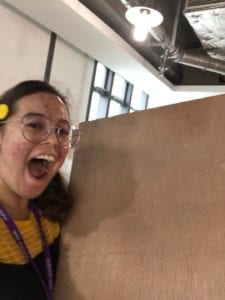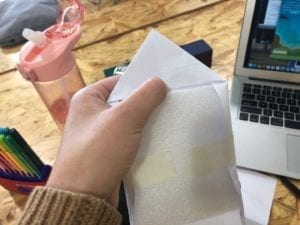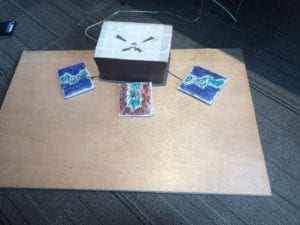I have not taken an IMA class since 2019, I have not even been in China since then either (very sad). Anyways here to post this external link to The Borgen Project which is a nonprofit I am working at NYU D.C. Our main goal is to pass global poverty alleviating bills in the U.S congress by grass roots network of volunteers (like myself). It is really cool stuff with lots of helpful info so take a visit to The Borgen Project!
Ball of Confusion- Citlaly Weed – Young
The title is a little more deep and needs some explanation:
you are a ball and the game you are playing sounds like Mario and looks almost like Mario, but it is not Mario you are then confused. However, the name is up to interpretation so another could be that the Ball that is confused is our planet. I did not want to just name in “Hey you are a ball jump, be active in not destroying our planet/ people.”
Anyways, I understood that much of the interaction that users were going to have would be pressing on the pressure sensors to move their character and focusing on how to get all the triangles. Using foam to cover the pressure sensors was one thing, but I also ended up decorating the foam to function as telling the user what each sensor was responsible for what direction. I also made them look like feet so it was it did not just become a cover-up for the sensors, but to look like tentacles so the user felt like they were stepping on corruptions feet. I also extremely unnecessary details like the box and the feet had triangles all without the body of the box and within/ around the tentacles. Andy also helped me out by allowing to use a giant plank of wood as our base. This help keeps the pressure sensor in place. There really was no need for any type of 3D printing; however, once I realized we could have used a laser cut box it was too late. A week beforehand I wanted to make sure we had something laser cut something, but the trouble with that is you can not see into the future to see what we needed. I printed a box with instructions, but we ended up putting instructions on the processing screen so my little box became useless. I just wish I realized we needed what I made in cardboard but as a neater laser cut monster.




In the beginning, we tried to use vibration sensors to sense when a person stomped or jumped. However, it was quickly clear that the vibration sensors were not sensitive enough. Eric then recommended that we used pressure sensors, but when I asked at the borrowing place if they had pressure sensors they said they did not. Nick then suggested we could make our own by using two layers of metal and one layer of foam with a hole in the middle so when the two metals touch the output is just like a pressure sensor. Again, we learned that making your own pressure sensor was difficult. The next day Olivia asked the borrowing people and they said they did have pressure sensors, so Olivia borrowed three. One was smaller so the outputs were not matching with the other pressure sensors so we exchanged the less sensitive pressure sensor with a bigger one so the outputs would be the same. During the User Testing, the sensors worked great and they never gave us any real trouble. The only thing was that people wanted the triangles to move and that the ball/ and gravity move faster or smoother. Also, Nick suggested putting labels on the sensors. We took all these suggestions and did them. And they were pretty successful since during the final presentation I did not have to explain why and what people were trying to catch and also I did not have to tell them what direction each sensor was. Also, I think the big change from the darker Mario background I edited to the original happy background was a good transition from the game to the end screen. Also, The links I added to the end of the game were not just educational, but were links to websites you could either donate or volunteer.
The goal was to get young adults to be more active in change. The ‘game’ was to stimulate through physically going after the bad guys of the world and the end page was where they can explore options in actually being active. My definition of interaction is that there are all different types no matter how big or small. Such as multivariable interaction like conversations versus someone trying to see the light go off in the refrigerator both stimulate a person brain somehow. This type of interaction takes the inputs and the determination of whoever is controlling the ellipse responding with it moving on the screen. Oaudiencecne reaction was pretty good to the playing of the ‘game’, but when the end came to the title screen I wish they would have spent more time on the websites they clicked or played again to click on a different website. If my abilities or time could not restrict me then I would have tried out making each level for one issue in the world and that you can not move on until you are educated on a subject or maybe even donate (but I am not trying for force people to pay money). I got to research a lot about things like Flint Michigan, or child labor in India, the current politics surrounding the rainforest, etc. Some that I had to understand was what I first envisioned to be my final project could not be a reality because of my lack of experience. However, that did not stop me to learn how to make my own classes in processing and how to code collision detection. Olivia and I tried our best, so the end product was still very fulfilling because we did something out of our comfort zones and it actually worked! Before this class, I would have never thought I could make something even close to this so thank you Young for teaching us I really appreciate it. The rubric says I need to do a final say “Why should anybody care?”
Mine is: our planet is dying and so are the people on it. Most of those people have no control over it especially things like war and global warming. So I hope that people as privileged as us can decide to help those less fortunate than us because we were born with it [privladge] to help.
Recitation 11: Workshops (Object Oriented Programming) – Citlaly Weed – Young
This was a fun and relaxed workshop Tristan did a great job! Learning OOP was difficult and a little still is, but after this workshop, I got a better understanding of how the different parts work together. For example, classing and making the object then in the actual code you can give it a method (what I know understand as giving the object a purpose). Anyways, we did a class for a person –> class Person, and first did the float of the x-axis, y-axis, the head size, and the body hight because these qualities are the ones we wanted to vary when we added them to the actual code (by using ArrayList). Then apparently there is something called void introduced where in the Console each person we add says their name, which I found very cute. So we added three people that I named one Bruce (who has “normal” size head), Jose (who has a really big head), and Brit (who has a small head size). Then after we did people.get(1).display(); in void draw we could see our wonderful lollipop friends. Lastly, we identified the radius for each person’s head so that when we would click on the identified area they would disappear. The background was boring so I wanted to spice it up a bit so I added background(255*mouseX/width, 255*mouseY/height, 255);. I actually turned into a game to be able to click on each person’s head before they disappear up.
https://www.youtube.com/watch?v=k6skshqRYkU
Recitation 10: Media Controller – Citlaly Weed – Young
After reading Computer Vision for Artist and Designers by Levin G. I really feel that my media controller on the standard of computer vision has no correlation. Computer vision seems to be described to have the need for manipulation/use of the computer’s camera or the computer controlling a camera/set of cameras. There is no way I can compare my controlling of a video speed to the Suicide Box by the Bureau of Inverse Technology (4). However, I guess the idea of Computer vision is more or less the manipulation of media/video (1). Also using the potentiometer the processing is detecting the change of speed of the video (5). Honestly, the overall making of it was funny to me because I use Mexican Banda music over an old Vine (that used to exist that was a short video sharing app ). I also ran into problems that Levin said I would where the video buffered and even crashed my processing app (5). No worries I got the help I needed and then they also pointed out the video I was using was big and that I should divide the int sensor1 = analogRead(A0) by 4 and the video popped up and started working! Really glad I could control the video speed while also using my meme skills to make something that people will not understand.
https://www.youtube.com/watch?v=A0hKVD_AS-s
Recitation 9: Final Project Process – Citlaly Weed – Young
- Malika – E-MAZE
- concept: A game where a player controls a ball with a handle where you are guiding the ball through a maze attempting to color the ground that will light up once the ball passes ontop a tile that serves as the ground. Each level will be designed to your own skill level that is dictated by the time you spend on the level.
- suggested improvements: There were two main suggestions. One was that once the ball hit the wall that there be a sound. The second was that there be a trial run so that the player can become familiar and the game does not use the unfamiliarity of the gamers play as their skill for future levels.
- my thoughts: I like it because there are many games where they have one single level ready to go, but here you can tell the game what level you are ready for. That feature of the game is the special part of the game.
- Caren – Ready, Get set, Guess!
- concept: A game where two players have to guess what/who is in a blurred picture (that will slowly unblur as time goes on) before the time runs out. There will be three buttons that correlate with three multiple choice options on the screen.
- suggested improvements: There were questions on when the game would end and if there would be different levels. I suggested that like the game Kahoot that depending on the time the person would guess that they would receive a certain amount of points. It was also suggested that there be two sets of buttons to better add up who’s point was who’s and also maybe what if there was a split screen.
- my thoughts: Again, I like it nothing like testing your recognition skills or maybe revealing how a little too deep you are in the pop culture scene by guessing all those popular memes. Overall sounds very fun to beat the clock and the other player.
- Jennifer – Labyrinth
- concept: A game where one play plays as Theseus, who is trying to solve/ get out of the labyrinth, and the other who is the Minotaur, who is trying to catch Theseus/ the other player. This game will be controlled by a joystick and on the screen will show a bird’s eye view of the labyrinth. Also, there is a heart rate thing in the beginning where you try to ‘charge’ it in the beginning and depending on how high your heart rate was that is how fast you will be in the game.
- suggested improvements: There was a great suggestion that maybe you can see the other player’s trail of where they had been. Also, maybe add a split screen if the trail seeing becomes apart of the game.
- my thoughts: I find this one pretty dope. I like the idea of two people up against each other like this battling it out and also getting some greek methodology in. Also, the heart rate thing is cool because you’re telling the software depending on how fast you can get your heart rate how fast you are going to catch/ run away from the player.
Interaction: It seems that between the other group members that have an established concept of what interaction has to be. For example, Jennifer believes that “I define interaction as a breakable cycle in which two or more actors’ outputs build off of and enact direct causation onto each other. One actor’s output is directly a unique result of other’s output”. When we where in the research group project I agreed with this definition. Now though I still agree with that concept; it works fine in my concept of levels of different types of interactions that can not be ordered in a hierarchy, but communicate interaction diffrently.
My project feedback:
I agree when they felt that my proposal was very stressful. Malika has done this before so she was real with me and said that this would be hard to code and the loading of an iagme would very demanding. They also said that the pop up screen that I wanted to try out might be too confusing while a palyer is tring to play. They suggesed that we should make levels and let is foucus on one issue. Actually that inspired me to keep the same idea, but that once you collect all the bad guys that the end card has a desciptions of each world issue. There was also concern about the vibration sensore, but Olivia mentioned that the only movemnt that the chracter would need is to jump because ‘gravity’ would cause the chracter to fall anyway if the perosn did not jump. Also it was suggested that maybe we could try out a DDR dance pad which I found cool. They were extreamly helpful and I will definatly watch out for any challegenes they warned me about! I will definatly be consider if a DDR dance pad is possible, but who knows. Overall they were very nice to share their wisdom.